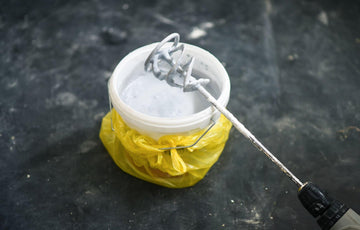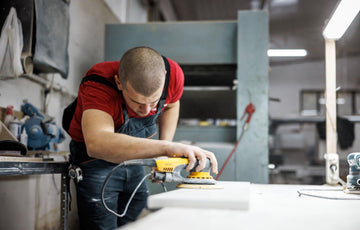Are you interested in woodworking or metalworking? It can be for your business or even DIY projects. If yes, chances are you are already familiar with a band saw. However, many beginners still often ask what a band saw is. Or what do you use a band saw for?
A band saw is a very versatile tool you can have in your workshop. It might not be as cool or powerful, but it’s definitely the most useful. It can handle both delicate curves and heavy-duty cutting. It can slice through tough materials like no other machine. It is useful for both DIY hobbyists who like to play around with wood or metal and for businesses as heavy-duty and reliable equipment.
Learning how to use a band saw is the way to use this versatile machine safely and accurately for clean, professional cuts. And for that, you need to understand its purpose and importance. Luckily for you, we have covered it all and much more in this guide to help you learn everything you need to know about a band saw. So, let’s go down the rabbit hole and learn some interesting things about band saws and how you can use them for individual or business needs.
What is a Band Saw?
Let’s begin with understanding the mechanism of a band saw and what it actually is. A band saw is simply a motorised power tool to cut different materials with precision. It has a continuous loop of a flexible, flat blade stretched between two wheels. Tension is applied between the two wheels to hold the blade in place.

How Does a Band Saw Work?
A band saw works in a single downward motion. The top wheel is attached to the motor that rotates the wheel. This spinning motion moves the blade loop. Most of the mechanism is hidden under covers. The only exposed part is the blade, which is used for cutting. The speed of the saw is also adjustable, which offers varied strength for different materials.
The mechanism of a band saw reduces any chances of dangerous kickbacks that are very common with other saws. The blade is covered with a protective blade guard to keep your hands safe while cutting. Many band saws often come with a bandsaw guideline light as well. This guideline light is used for precision cutting.
The unique build of the band saw allows cuts in curves and angles, which is something circular saws can’t do. It can even cut irregular shapes with ease. That’s why a band saw is an invaluable tool in your workshop to do a vast variety of work.
Types of Band Saw
Band saws come in a few varieties that are effective for different uses. Each band saw is ideal for a specific material. Some have fine-toothed blades, some have aggressive tooth blades. Even the width of the blade varies. Hence, you need to know which type is best suited for which type of material to get the best results.
There are basically two types of band saws. Benchtop and floor-standing. The working mechanism is almost similar for both. The only difference is in design. Let’s have a detailed look at both:
1. Benchtop Band Saw: This is somewhat of a portable version. You can place it on a workbench when needed and store it away when you are done. The design is very lightweight and compact. However, it can be a bit unstable. You can clamp it on a table to rectify this issue.
2. Floor-standing Band Saw: As the name suggests, this band saw stands on the floor. It's larger in size and not portable. Due to its heavy build, it does not vibrate much, offering better stability. However, this advantage can be a disadvantage as well. The large size takes up a lot of space and can be unsuitable for smaller shops or DIY projects.
Other types include vertical band saws, which are good for wood cutting or intricate cuts. For metals, you need the best horizontal band saw for metal cutting.

What do You Use a Band Saw for?
Band saws are usually used for woodworking and metalworking. The question is which work? There are many uses for a band saw. Here are some common uses for a band saw:
- Cut intricate designs or curves on both wood and metal
- Resaw large chunks of metal or wood into thinner or smaller pieces
- Crosscut boards lengthwise for different purposes
- Rip wooden boards to the desired width
- Metal cutting to get pieces for fabrication or welding
- Mitre cutting to make frames and other DIY projects
- Create dovetails to tenons for joinery
The band saw is your reliable companion if you need a saw to cut through metal or wood. Surprisingly, the uses don’t end with wood and metal only. Using a band saw is also common in professional butcher shops. They use a cutting band saw for slicing large cuts of meat and bone.
Step-by-Step Guide on How to Use a Band Saw Safely
Learning how to use a band saw safely is essential. Accidents can happen, and following proper protocols can prevent them. So, let’s go through a step-by-step guide to use a band saw properly and safely:
Step 1: Prepare Your Work Area
First of all, you need to prepare the area to work. Make sure there are no loose tools or debris nearby. Adjust your workbench for stability or make a DIY band saw stand. Put everything in place before anything. Ensure there's good lighting. Turn on the bandsaw guideline lights if you have.
Step 2: Check the Band Saw
Once your work area is ready, check your band saw. Make sure the blade tension is in the right position. A loose blade will lead to uneven or wandering cuts, while an overly tight blade can cause premature wear, blade breakage, or even damage to the saw. Always refer to your band saw’s manual for an accurate tension range; most of the blades fall between 15,000 and 25,000 PSI, depending on their width and material. Also, make sure at least one blade guard is in place and verify that the wheels are tracking the blade correctly.
Step 3: Mark Where You Need to Cut
You can use a chalk or a pen to mark your cuts. You can even use a laser guideline for precision cutting. Marking your material before cutting ensures you get the perfect results.
Step 4: Set Up Your Material
Clamp your material securely with a side band clamp so it doesn’t move during cutting. Select the right blade TPI (teeth per inch). The finer the better, especially for thin metals. You can use a bend saw clamp for round pieces like pipes or rods.
Step 5: Wear Protective Gear
Once your band saw and material are all in place, it’s time to gear up for safety. Wear your safety glasses to protect your eyes from fine particles from cutting.
Step 6: Cut & Inspect
Finally, start the machine and let it reach its full speed. You can adjust the speed as per your need. Then start feeding your material to the blade, following the guides you made earlier. Make sure to be slow and steady.

DIY & Workshop Accessories for Your Band Saw
Band saws are very adaptable. And good news for DIY enthusiasts. You can enhance a band saw’s functionality with some simple DIY upgrades.
undefined You can build a custom DIY band saw stand to achieve more stability during cuts. It’ll serve as a place for your materials during cutting. You can adjust the height as per your needs for ergonomic results.
undefined You can also add a bandsaw guideline light if you don’t already have one. It can help you make precise cuts. You can switch the simple bandsaw guideline light with a laser guideline for even better results.
undefined Mitre saw stand DIY is another option for a stable stand for longer objects like pipes or rods. You can even make them adjustable for different lengths of pipes and wood logs.
undefined Make some DIY side band clamps to keep the material aligned and in place for a safer cut. It will hold your objects in place tightly so it doesn't move even with the rigorous vibration of the blade.
Top 10 Safety Tips for Using a Band Saw
A Band saw is a very versatile tool, which can be used for a variety of purposes. However, they don’t come with safety features. That’s why it's essential to follow some practices to keep yourself from hurting while using a band saw. Here are some safety tips that we recommend you follow to avoid any dangerous situations and prevent accidents:
1. Wear proper protective gear to keep yourself from getting hurt. You should use personal protective equipment (PPE) every time you operate a band saw. It should have safety glasses and hearing protection. You should also add a mask to avoid inhaling any wood dust or metal shavings. Band saws are quiet themselves, but they can get loud when cutting certain materials.
2. Always wear tight-fitting clothes. Loose clothes are a potential hazard as they can get caught on the blade. Moreover, make sure to tie your hair back if you have long hair. They can also get caught in the blade. Gloves aren't necessary, but if you must wear them, make sure they are tight. Loose gloves can snag on the machine and pull your hand with it, which can be extremely dangerous.
3. Remove any jewellery, especially if it's exposed. Certain jewellery can get stuck on the blade, or it can even get damaged due to constant exposure to sawdust.
4. Make sure you always check the machine before use. Check every piece of the blade and the motor. Make sure the tension is right and the motor is not overheating.
5. Check the guidelights and set them in the right position. It will help you cut precisely and ensure the blade is working properly.
6. Make sure to use one blade guard to cover the blade. It will prevent any accidents while using a band saw.
7. Keep the work area clean. The floor around the band saw should be clean of any debris to ensure a stable platform for your band saw. It’ll ensure a safe footing while cutting, and you won’t lose balance.
8. Use a push stick for feeding the material to the blade, especially if you are using very thin material. It’ll secure your fingers from the blade.
9. Abide by the four-inch rule. Keep your hands at least four inches away from the blade. If you need to get closer for intricate cuts, always use a push stick.
10. Each material needs a distinct blade. So, use the proper blade for each material; if you use a wood blade on metal. It’ll damage the blade and even dull it. The tooth may break and fly through the air.
Why You Should Invest in a Band Saw for Business?
Most people use a band saw for home projects like making frames or furniture. However, the real work of a band saw is in the professional business. A professional-grade band saw offers enhanced efficiency and saves a lot of time. Band saws provide faster and cleaner cuts, which are essential for professional work.
Moreover, they are versatile. So, investing in a high-quality band saw means you don’t have to get different machines for different materials. You can just have one band saw and it’ll work for both metal and wood. It can even cut plastic pipes or even bones.
Professional workshops often have bulk work. Luckily, band saws can handle high-volume operations. That’s why they are perfect for businesses. These machines are highly durable as well. Meaning it’ll outlast most of your small equipment. A one-time investment that’ll last you for a long time.
Final Thoughts
A band saw is a versatile tool that can cut through any material. It can be used for both metals and wood. You can even cut plastic and meat with a band saw. It is an invaluable tool for woodworking and metalworking. Learning how to use a band saw will save you both money and time. You will get professional results with a fraction of the effort.
All you have to do is follow some safety tips and maintain it properly. This investment will last you ages and will make your work smoother and faster. If you are ready to equip your shop with a great band saw, explore HyperFit Tools' full collection to find the best one for you.




